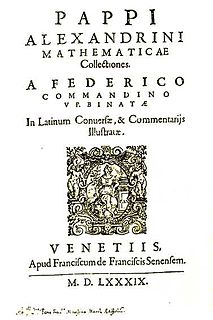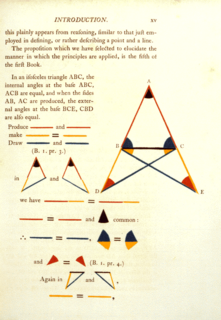
Euclid, sometimes given the name Euclid of Alexandria to distinguish him from Euclides of Megara, was a Greek mathematician, often referred to as the "founder of geometry" or the "father of geometry". He was active in Alexandria during the reign of Ptolemy I. His Elements is one of the most influential works in the history of mathematics, serving as the main textbook for teaching mathematics from the time of its publication until the late 19th or early 20th century. In the Elements, Euclid deduced the theorems of what is now called Euclidean geometry from a small set of axioms. Euclid also wrote works on perspective, conic sections, spherical geometry, number theory, and rigor.
Proclus Lycaeus, called the Successor, was a Greek Neoplatonist philosopher, one of the last major classical philosophers. He set forth one of the most elaborate and fully developed systems of Neoplatonism. He stands near the end of the classical development of philosophy, and was very influential on Western medieval philosophy.

Menelaus of Alexandria was a Greek mathematician and astronomer, the first to recognize geodesics on a curved surface as natural analogs of straight lines.
Eudoxus of Cnidus was an ancient Greek astronomer, mathematician, scholar, and student of Archytas and Plato. All of his works are lost, though some fragments are preserved in Hipparchus' commentary on Aratus's poem on astronomy. Sphaerics by Theodosius of Bithynia may be based on a work by Eudoxus.

Apollonius of Perga was a Greek geometer and astronomer known for his theories on the topic of conic sections. Beginning from the theories of Euclid and Archimedes on the topic, he brought them to the state they were in just before the invention of analytic geometry. His definitions of the terms ellipse, parabola, and hyperbola are the ones in use today.
Theon of Alexandria was a Greek scholar and mathematician who lived in Alexandria, Egypt. He edited and arranged Euclid's Elements and wrote commentaries on works by Euclid and Ptolemy. His daughter Hypatia also won fame as a mathematician.

Pappus of Alexandria was one of the last great Greek mathematicians of Antiquity, known for his Synagoge (Συναγωγή) or Collection, and for Pappus's hexagon theorem in projective geometry. Nothing is known of his life, other than, that he had a son named Hermodorus, and was a teacher in Alexandria.
Nicomachus of Gerasa was an important ancient mathematician best known for his works Introduction to Arithmetic and Manual of Harmonics in Greek. He was born in Gerasa, in the Roman province of Syria, and was strongly influenced by Aristotle. He was a Neopythagorean, who wrote about the mystical properties of numbers.

In geometry, the statement that the angles opposite the equal sides of an isosceles triangle are themselves equal is known as the pons asinorum, typically translated as "bridge of asses". This statement is Proposition 5 of Book 1 in Euclid's Elements, and is also known as the isosceles triangle theorem. Its converse is also true: if two angles of a triangle are equal, then the sides opposite them are also equal.

Iamblichus was a Syrian Neoplatonist philosopher of Arab origin. He determined the direction that would later be taken by Neoplatonic philosophy. He was also the biographer of Pythagoras, a Greek mystic, philosopher and mathematician.

Hippasus of Metapontum, was a Pythagorean philosopher. Little is known about his life or his beliefs, but he is sometimes credited with the discovery of the existence of irrational numbers. The discovery of irrational numbers is said to have been shocking to the Pythagoreans, and Hippasus is supposed to have drowned at sea, apparently as a punishment from the gods for divulging this. However, the few ancient sources which describe this story either do not mention Hippasus by name or alternatively tell that Hippasus drowned because he revealed how to construct a dodecahedron inside a sphere. The discovery of irrationality is not specifically ascribed to Hippasus by any ancient writer. Some modern scholars though have suggested that he discovered the irrationality of √2, which is believed to have been discovered around the time that he lived.

Thomas Taylor was an English translator and Neoplatonist, the first to translate into English the complete works of Aristotle and of Plato, as well as the Orphic fragments.

Greek mathematics refers to mathematics texts and advances written in Greek, developed from the 7th century BC to the 4th century AD around the shores of the Eastern Mediterranean. Greek mathematicians lived in cities spread over the entire Eastern Mediterranean from Italy to North Africa but were united by culture and language. Greek mathematics of the period following Alexander the Great is sometimes called Hellenistic mathematics. The word "mathematics" itself derives from the Ancient Greek: μάθημα, translit. máthēmaAttic Greek: [má.tʰɛː.ma]Koine Greek: [ˈma.θi.ma], meaning "subject of instruction". The study of mathematics for its own sake and the use of generalized mathematical theories and proofs is the key difference between Greek mathematics and those of preceding civilizations.
Diocles was a Greek mathematician and geometer.
Geminus of Rhodes, was a Greek astronomer and mathematician, who flourished in the 1st century BC. An astronomy work of his, the Introduction to the Phenomena, still survives; it was intended as an introductory astronomy book for students. He also wrote a work on mathematics, of which only fragments quoted by later authors survive.
A porism is a mathematical proposition or corollary. In particular, the term porism has been used to refer to a direct result of a proof, analogous to how a corollary refers to a direct result of a theorem. In modern usage, a porism is a relation that holds for an infinite range of values but only if a certain condition is assumed, for example Steiner's porism. The term originates from three books of Euclid with porism, that have been lost. Note that a proposition may not have been proven, so a porism may not be a theorem, or for that matter, it may not be true.
Aristaeus the Elder was a Greek mathematician who worked on conic sections. He was a contemporary of Euclid.
Domninus of Larissa was an ancient Hellenistic Syrian mathematician.
Theodorus of Asine was a Neoplatonist philosopher, and a native of one of the towns which bore the name of Asine, probably Asine in Laconia.

The quadratrix or trisectrix of Hippias is a curve, which is created by a uniform motion. It is one of the oldest examples for a kinematic curve, that is a curve created through motion. Its discovery is attributed to the Greek sophist Hippias of Elis, who used it around 420 BC in an attempt to solve the angle trisection problem. Later around 350 BC Dinostratus used it in an attempt to solve the problem of squaring the circle.











